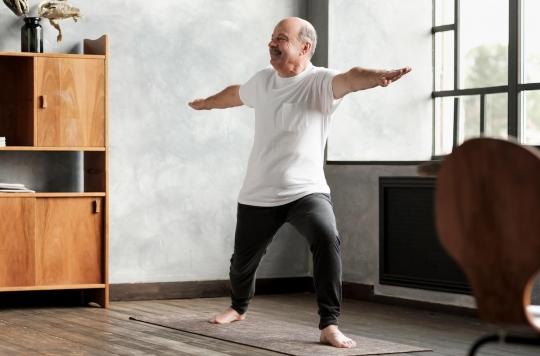
Not only good for your buttocks
Whether you’re doing a boot camp or body pump workout or getting started with a training app, it’s a welcome guest in most programs: the squat. Many trainers are enthusiastic about these knee bends and your body will also be quite happy – if you do it right of course. What is the power of the squat?
It is arguably one of the most important exercises you can do. It looks like a glute and leg exercise – you definitely train your hamstrings, glutes, calves and thigh muscles – but actually squatting is a full-body exercise. Good posture is also very important and you train your back and abdominal muscles. In addition, with a squat you not only work on your strength, but you can also burn a lot of fat. Especially if you squat at a fast pace. However, good technique is of great importance.
A good squat
The squat is sometimes thought to be bad for your knees, but if you do the exercise right, the opposite is true. Squatting can actually improve the stability of your knees. Simply put, the squat actually involves sitting down on an imaginary chair and then coming back up. Please note the following:
- Make sure your muscles are well warmed up.
- Place your feet slightly wider than shoulder width, with your toes pointing slightly out.
- Keep your back straight and stand with your knees slightly bent.
- Slowly lower your knees while continuing to look straight ahead and keep your back straight until your knees are about a 90-degree angle and your thighs are parallel to the floor. Make sure your knees don’t go past your toes.
- Come back up to the starting position.
Inhale as you lower your knees and exhale as you come back up. That way you tighten the abdominal muscles in the right way and it also contributes to your stability. You can move your arms with it, for example straight in front of you when you sink. Also make sure you squat deeply enough. Do you want to check yourself? Try it with a chair. When done correctly, your butt should touch the seat. Other points of attention are:
- Keep your ankles, knees and hips in line.
- Maintain a neutral spine, keep your back straight and keep looking straight ahead.
- Keep the weight in the middle of your foot.
- When you’re down, tighten your glutes and go straight up.
Functional exercise
The squat is a so-called functional exercise, an exercise from everyday life. You actually squat all day long if you sit on a chair. Functional exercises are not aimed at training a specific muscle group, but at the functioning of the entire body. The goal is to move more efficiently in everyday life.
With the squat you train several muscles at the same time and you improve coordination and core stability, among other things. This will make it easier for you to get up from a chair, for example, but also to lift better.
Improves sports performance
Many athletes are also avid squatters. The squat can improve performance, especially in sports where you have to run or jump a lot. Thanks to more power in your legs, you can react more explosively.
In addition, squats strengthen tendons, bones and ligaments in your lower body and increase the mobility and flexibility of the body. This reduces the chance of injuries. Many injuries are also caused by weak and underdeveloped muscles. You can also overcome this by squatting.
Variations on the squat
Like most other exercises, the squat also requires you to build up slowly. For example, start with three sets of 15 reps. If you are just starting to squat, you may not be able to sink into a 90-degree angle yet. Then see how far you get and stick to that depth. You will see that you will progress on your own.
If you can do that without any problems – and with good technique, you can slowly build up. In the number of repetitions, for example, but there are also different variations. A selection:
- Deep squat: Instead of lowering until your knees have reached a 90-degree angle, a deep squat lowers you even further. To a squat position.
- Sumo squat: Put your feet wide and out. Your knees also point outwards. Then bend your knees with your hips back. You can also do the sumo squat on your toes.
- Jump squat: After you drop into the squat, jump up explosively. Country controlled.
- Side squat: Step out with your right foot so that your legs are wide. Then drop through your right leg and hold left leg stretched. Come back up and shift your weight to your left leg. Sink through that while keeping your right leg straight. This side squat you can also perform without stretched legs.
- With kettlebell: You can make the squat more difficult by holding a kettlebell or dumbell in front of your chest. The technique of the squat remains the same. If you hold the kettlebell straight in front of you with outstretched arms, you also train the upper body considerably.
- With barbell: Rest a barbell (with weights) on top of the back (on the trapezius muscle). The technique is basically the same as with the basic squat.







